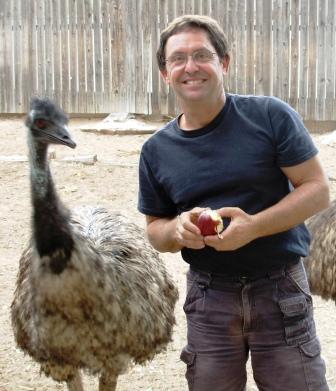
With the collapse of
a livestock bubble,
the giant bird is now
the mark of a 'weirdo'
Back in 1990, when the flightless bird fromAustralia was poised to swoop onto Americandinner tables, you could get $4,000 foran unhatched emu chick, and $40,000 for abreeding pair—not a bad return on investment for speculators who got in early. Texans were especiallyprone to thinking large: By 1997 there were morethan a million emus on U.S. ranches, mostly in the LoneStar state, all waiting for Americans to catch on to “theother red meat.”
“They were going to be next big thing,” chuckles Bruce Hofkin, who bought a pair in 1996, after the market crashed,for just $200. A biology professor at UNM and self-professedanimal nut, hofkin discovered the ratites (an ancient birdorder that includes ostriches, kiwis, and rheas) at the ranchof the late John A. Moore, onetime director of the Rio Grande Zoo, who bred all kinds of exotic birds.
Hofkin and his girlfriend Leslie Kranz picked one each, dubbed Sydney and Sheila. “For the first six months wetreated them like divorced parents,” says Kranz. “They’d walk up the ramp into the Ford Explorer and live part ofthe week together with each parent.”
Shuttling the birds between her home in the North Valley and his in Corrales got old, however, as the birds grewfrom darling little skunk-striped chicks to blocking therearview mirror of the SUV. “I’d go to the drive-throughat Mcdonald’s and people were like, Whoa.”
“Meanwhile, we found out about all the emu fanatics,”Hofkin adds. At one time there were emu associations,emu cooperatives, emu journals, emu processing plantsbuilt with public money to create jobs and industry in failing-farm states like Mississippi and Kansas. But Sydneyand Sheila escaped the fate of so many of their brethren,who ended up released, starved, and clubbed to deathwhen it turned out there was no market for their meat.
“We never wanted to breed them or eat them,” saysHofkin, who just considers emus to be the coolest pets.“They don’t smell, they don’t make a mess. They’re notpicky about food; I feed them like chickens. They’re fairlycold-tolerant, and the heat and rain don’t seem to bother
them. They do run around and chase the llamas, who don’t like them.”
They also like shiny things, and might come over tomeet an especially friendly pair of earrings. Hofkin swearsthat his second-generation emus, Mattie and Tazzie, caninstantly sum up a visiting human.
The offspring of Sydney and Sheila, Mattie used to live with Kranz—but don’t try tosort out the family tree. Sufficeit to say that Hofkin and Kranz each ended up with multiple emus, and one ofhers made the evening news last year when it escaped and sparked a three-agency emu huntin the North Valley that lasted five hours. Atticus dropped dead of stress afterward,Kranz says sadly.
The comical birds picktheir way toward outstretched hands of fruit, then trot offlike goose-stepping roadrunners.With large three-toedfeet like raptors, little vestigialwings, and tiny heads withodd bald patches, they are oftendescribed in news reportsas ugly (or, more diplomatically,“strange looking”). ButHofkin finds them engagingand adorable. “They want to
be with people,” he says, grabbingone around the neck fora sort-of hug. “They’re gentle
and curious. Not loud.”
Mattie, the female, emits a low drumbeat sound fromher inflatable neck sac. When they mate—which is fairlyoften starting in the fall, Hofkin says—she’s the one whogives the go-ahead by puffing herself up and paradingaround before showing Tazzie her rump.
Hofkin proudly displays what looks like a large blue-green oval stone. Mattie lays around 30 eggs a year, whichit would be Tazzie’s job to brood uninterrupted for eightweeks, going without food or water. Happily for him, Hofkin spirits away the eggs, which enjoy a niche market
in the world of little-sung crafts.
Emu eggs have seven layers of green followed by a layerof white, says Kranz, and a quick search of the Internetwill indeed turn up emu eggs painstakingly carved (withdentist drills) with wildlife scenes, Victorian motifs, fairies,angels, and the likeness of Michael Jackson. Emu feathersare also prized for their two long shafts on a single stem,like wispy ferns.
“There’s all kinds of weirdos like us around,” Hofkin grins, though he can hardly think of any emu owners in Corrales,or any ranches remaining in New Mexico. The ones whohung in after the collapse of what he calls “a pyramidscheme” have found a modest market for emu oil, which issaid to have curative properties. A few birds get made intobelts and wallets. But many these days are simply backyardpets, like llamas and pot-bellied pigs—two other bubblemarkets for exotic livestock.
Terry Turner, vice president of the American Emu Association,attributes the precipitous decline in emu ranchingto people jumping into the market without realizingthey would have to market their products and educate theAmerican consumer—who proved to be “just not real adventuresome”when it came to the lean, beefy meat whichis truly fabulous, she says. “Mostly our business is drivenby small farmers attending farmer’s markets, and thenword of mouth. Emu oil was not a household word in1990. Now we have people who walk up to our booth and
say they have heard of it and need some.”
An online listing of emu ranches still shows scores ofthem in Kansas and Washington state, fewer in Tennessee,and fewer still in Texas and California. “There are a lot ofpeople with pets, which is what we’re seeing now,” admitsTurner, adding that she can’t really recommend this use.
“They’re just not like a dog or cat or even a Shetland pony.Emus tend to be aloof, just kind of in their own little world.They’re not real interested in people” unless you “hang inthere for a long time.” Or unless you are—even more thanthe average llama owner—kind of a weirdo.
Leslie Kranz's runaway emu sparks a three-agency hunt in the North Valley
